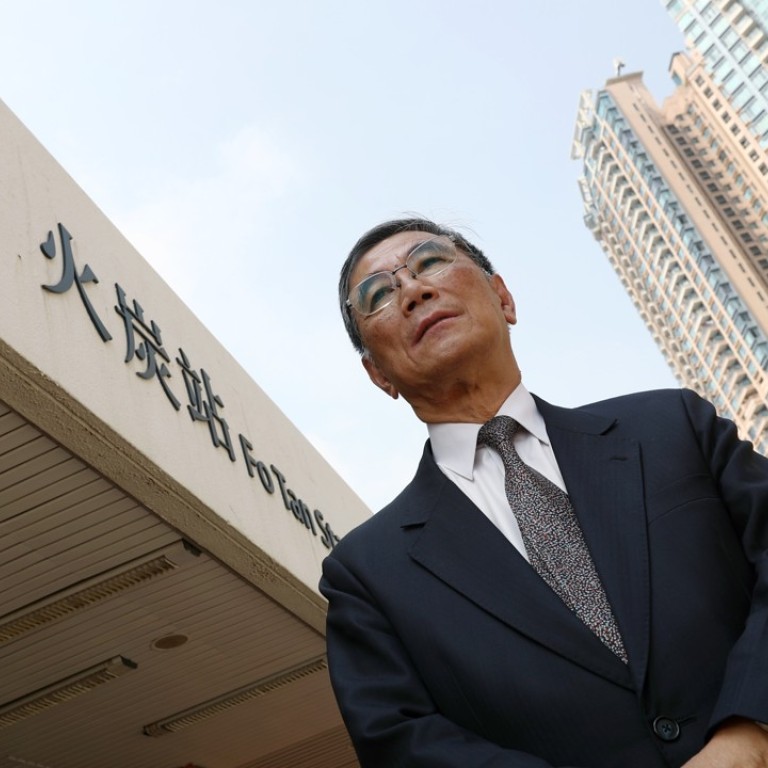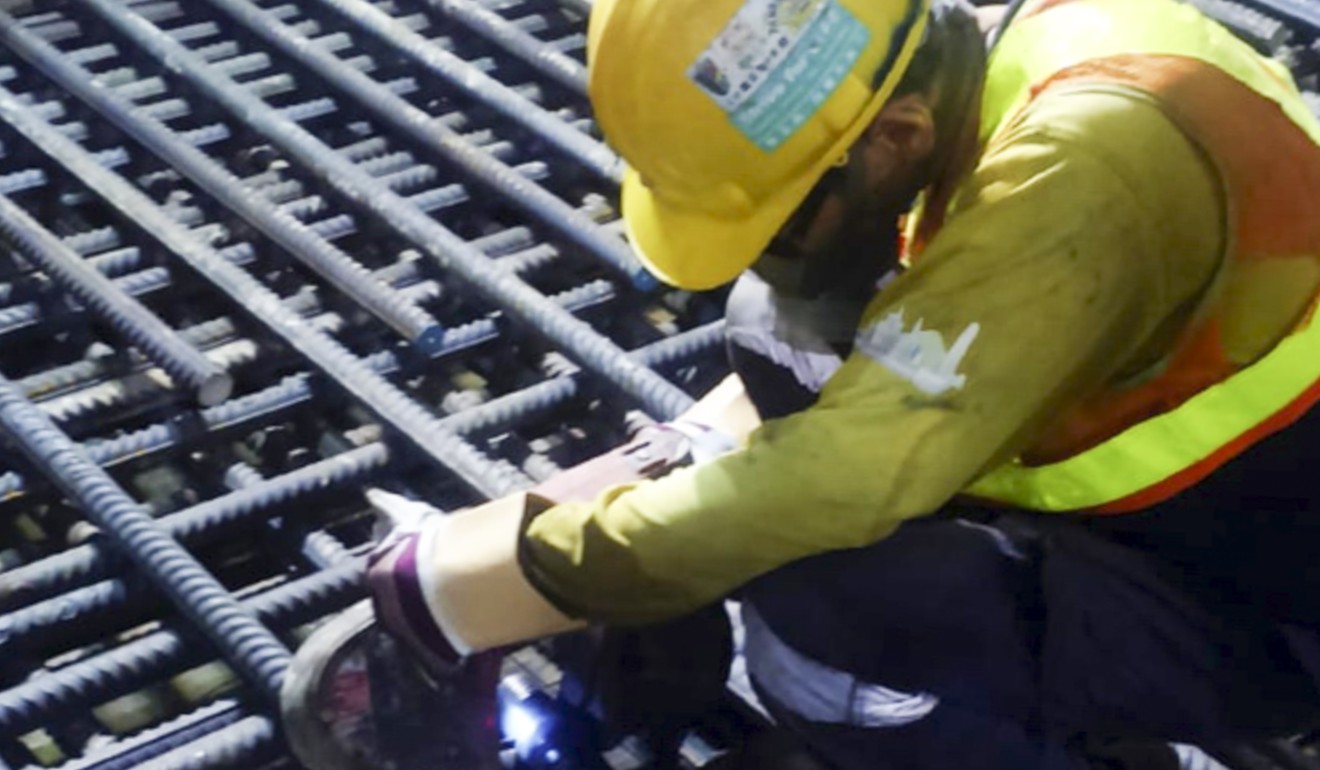
How Hong Kong’s MTR Corp ‘lost its focus’ – former construction head says embattled rail giant should return to serving public interest
Daniel Lam, who headed Housing Authority projects involving sites at train stations says past crisis response was swift and absolute, unlike now
There are not many things in Daniel Lam Chun’s life that have caused him sleepless nights, but the events of January 2000 are still vivid in the mind of the former chairman of the Housing Authority’s building committee.
At a press conference on January 8 that year, Lam revealed that the piling on two government-subsidised housing blocks in Yuen Chau Kok, Sha Tin, was 13 and 10 metres shorter than required.
The announcement involving the two 34-storey buildings came five days after authority staff had discovered the flaws during an inspection of 106 construction sites of public rental and subsidised flats.
MTR misery continues as 130 locations on high-speed link are sinking
“The inspection was actually initiated by the authority’s building committee,” Lam explained. “It was after we were informed the same problems had happened to the construction sites at Kowloon station and Hong Kong station.
“Soon after that, I was shown preliminary findings that uneven subsidence was found at one of our construction sites in Sha Tin, and the piles could be shorter than expected.
“While waiting for further review and confirmation, I could not sleep at all. About 1,000 secondary school students were studying in their campus, not less than six metres from our site. We didn’t know on which side the two housing blocks would fall, if they did.”
A bit of history repeating
The scandal came as then chief executive Tung Chee-hwa pledged to offer Hongkongers 85,000 new homes a year. Not long afterwards, the authority confirmed the short-piling problem had spread from MTR’s construction sites to at least four public housing sites – developments in which the same contractor was involved.
Almost two decades later, the city is facing another spate of scandals plaguing two mammoth rail projects: the high-speed cross-border rail link and the Sha Tin to Central line.
How an MTR buy-back can solve our transport problems
Unauthorised construction – from shortening steel bars in the platform of Hung Hom station on the line, to walls that have been shaved thin at To Kwa Wan station – has been uncovered in the HK$97.1 billion project. At HK$16.5 billion over budget, the link is the most expensive railway development in the city’s history.

“MTR has lost its focus,” Lam said. “It’s expanding its network and getting more projects overseas, but it nearly forgets about taking care of public interests. It needs competition and a refocus on what the public really needs.”
MTR has lost its focus. It needs competition and a refocus on what the public really needs
Lam has plenty of experience dealing with the MTR Corporation in various semi-government bodies, including as a former managing director of the Urban Renewal Authority and now as a board member of the Hospital Authority.
After the scandal in 2000, Lam joined the Kowloon-Canton Railway Corporation (KCRC) – a statutory public corporation wholly owned by the government – as a property director, and quit his job after the merger of the two rail companies in 2007.
The need to rebuild public confidence
This time around, the MTR Corp’s board was not aware of the construction problems until they were exposed in the media. Three months later, the rail operator has yet to clarify if it will rebuild the platform at Hung Hom.
Lam said the Housing Authority was relatively decisive 18 years ago.

“We also decided to demolish the two blocks, although some experts advised otherwise. It was a difficult decision, but it was the best way to rebuild public confidence.”
Wong, an Exco member at the time, stepped down in June 2000 ahead of a no-confidence vote by lawmakers, conceding she had lost the trust and support of the public. Lam said she had offered to quit three times before Tung finally accepted her resignation.
“Members of the Housing Authority faced increasing pressure,” Wong said as she announced her departure on June 24. “They should not be dragged into political disputes and worries. To immediately ease the pressure and difficulty on members, and the impact on the authority, resigning immediately is appropriate.”
Has the MTR lost all control over its contractors?
Did the public benefit from the merger between MTR Corp and KCRC?
Lam, who opposed the merger 11 years ago, said the MTR Corp’s monopolisation of the market had greatly reduced its incentive to improve.
“The merger did not bring down ticket fares significantly, and little synergy has been seen,” Lam said. “KCRC and the MTR Corp trains cannot use each other’s rail network because they work on different voltage.
Former MTR projects director to resign as head of engineering institute
“Back then, when Yeung Kai-yin [KCRC’s CEO] was still in charge, he locked up the projects’ contingency fees. If a project was over budget and needed to dip into the contingency, the project’s head had to go back to Yeung for approval, even if it was only for an extra HK$1.”
In fact, it was KCRC that won the tender for the Sha Tin-Central link before the merger.
Lam believed the MTR Corp had greater issues to deal with politically, including filibustering by lawmakers, and admitted there was more competition for resources and workers among cities in the region. But, he added, the scandals reflected problems in the rail operator’s culture.
“Back then, I always told my colleagues: ‘Work with your conscientiousness. The projects you are working on are not for your generation but the next generation’,” said Lam, who also led a challenging project at Fo Tan station.
Back then, I always told my colleagues: ‘Work with your conscientiousness. The projects you are working on are not for your generation but the next generation
The property development located atop Fo Tan station, now known as the Palazzo, was once abandoned by developer Sun Hung Kai in the 1990s due to the challenging nature of the build, which involved putting residential towers on top of a depot and a rail track that operated 24 hours a day.
To complicate matters, the development was right next to the Tolo Highway.
“Anything dropped from the construction site could have been detrimental. With good teamwork, the project was eventually completed with success,” said Lam, who carried out regular site inspections.
He conceded that KCRC had its own problems, most notably the Siemens scandal when the West Rail was under construction.
The company was accused of paying an extra HK$100 million to the German communications giant, despite its failure to meet contract requirements. Still, the line managed to open as scheduled in 2003.
Does the MTR Corp exists to serve the public?
“The recent scandals raise an alarm,” Lam said. “Is the city’s construction system getting any better 20 years after the short-piling? What is the real value to our society? How do we treat our workers?”.
He questioned if the MTR Corp had done its best to serve the public.
Lam said authorities’ efforts to persuade the MTR Corp to plan covered corridors to connect new stations with hospitals, as well as Kwun Tong station with the new Kwun Tong centre, had been in vain.
Government and MTR Corp must wipe out public works blunders
“Even back to basics, 11 years after the merger, we don’t have a washroom for each station, and platform screen doors have not been installed for the East Rail Line. Some aprons installed on East Rail trains to minimise noise pollution have even been removed.”
In response, an MTR Corp spokesman said it had been building toilets for passengers in 10 interchange stations and their staff toilets were open for public use. He added that the reduction of East Rail aprons was a balance between the functions of cooling and noise reduction.
The spokesman said the company would discuss further with the Hospital Authority and the Urban Renewal Authority on the possibility of providing sheltered walkways.
Lawmaker Michael Tien Puk-sun, a former KCRC chairman who supported the merger, has now proposed that the government buy back the company to exert stronger supervision. The government holds more than 75 per cent of the MTR Corp’s shares.
“Let’s not forget about [the firm’s] origin,” Lam said. “It exists to serve the public. This is the key, regardless of which management model is adopted.”
Major construction crises in Hong Kong over the past two decades
2000: faulty piling found at Housing Authority’s construction sites
January 3: Two 34-storey housing blocks of subsidised flats in Yuen Chau Kok, Sha Tin, are found to have only three piles out of 36 that meet required standards
January 21: Decision made to demolish the two blocks in Sha Tin
February 15: Housing Authority insists five blocks of flats in Tin Shui Wai with seriously defective piling will not be demolished but repaired
May 25: An independent inquiry into the Sha Tin scandal implicates 10 Housing Department staff but clears senior officials
May 31: The Ombudsman announces an investigation into how the authority and Housing Department manage construction projects
June 2: Three men convicted for taking part in Tung Chung station piling scam
June 13: A new government panel is set up to investigate possible civil service misconduct over faulty piling
June 14: Democratic Party lawmaker Fred Li Wah-ming proposes a vote of no confidence against Housing Authority chairwoman Rosanna Wong Yick-ming and director of housing Tony Miller
June 24: Wong announces she will step down
2002: cost underestimated for West Rail project
January 28: Kowloon-Canton Railway Corporation (KCRC) defends its decision to pay Siemens, its contractor responsible for building the West Rail’s communication systems, an extra HK$100 million
January 30: The KCRC commissions an independent auditor to review the matter
March 4: KCRC chief executive Yeung Kai-yin tells lawmakers that Siemens’ bid was 66 per cent lower than what the rail firm had estimated the work would cost
May 16: Yeung apologises for not earlier telling the board about the Siemens contract problems
2014-15: delay in completion of Guangzhou-Shenzhen-Hong Kong Express Rail Link
April 15: MTR announces the mega project will be delayed by up to two years because of “unforeseen difficulties” including a tunnel-boring machine damaged due to heavy rain
April 29: MTR’s board sets up an independent committee of non-executive directors to review the project’s management and find out why it was not briefed earlier on the problems
May 2: Cheung sets up an expert panel to investigate the project and the government’s role
May 8: MTR announces its chief executive Jay Walder will leave his job after his contract ends in a year
January 30, 2015: A report criticises the rail operator, saying it was “discouraging elevation of bad news without solutions”
2017-18: fake concrete test results spotted for the Hong Kong-Macau-Zhuhai Bridge
June 16: The government reveals that the contractor Jacobs China faked dozens of results at another 55 public projects including a tunnel in Causeway Bay and a children’s hospital
November 11: The ICAC charges 19 laboratory staff alleged to have used high-strength concrete cubes or a metal calibration cylinder to substitute the original concrete samples for compliance testing
July 25, 2018: Two technicians are sentenced to jail for falsifying safety test results

